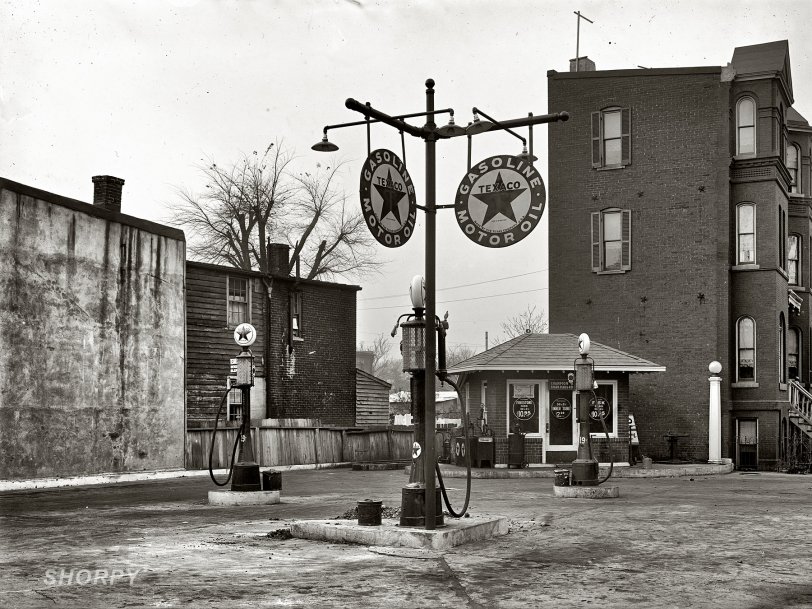


Framed or unframed, desk size to sofa size, printed by us in Arizona and Alabama since 2007. Explore now.
Shorpy is funded by you. Patreon contributors get an ad-free experience.
Learn more.

- Freeze Frame
- Texas Flyer wanted
- Just a Year Too Soon
- WWII -- Replacing men with women at the railroad crossing.
- Yes, Icing
- You kids drive me nuts!
- NOT An Easy Job
- I wonder
- Just add window boxes
- Icing Platform?
- Indiana Harbor Belt abides
- Freezing haze
- Corrections (for those who care)
- C&NW at Nelson
- Fallen Flags
- A dangerous job made worse
- Water Stop
- Passenger trains have right of way over freights?
- Coal
- Never ceases to amaze me.
- Still chuggin' (in model form)
- Great shot
- Westerly Breeze
- For the men, a trapeze
- Tickled
- Sense of loneliness ...
- 2 cents
- Charm City
- What an Outrage
- Brighton Park
Print Emporium
Texaco: 1925

Washington, D.C., 1925. "Texas Company station, Rhode Island and New Jersey avenues." View full size. National Photo Company Collection glass negative.
The big bright Texaco star
"You can trust your car to the man who wears the star."
Back when they pumped your gas, cleaned your windows all around (without a squeegee) and checked under the hood looking for worn belts and hoses while pulling the dipstick.
I recently found a service station off I15 outside Helena, Montana, that did that and more. They offered self and full service. Full service cleaned both the outside and inside of all my windows. There were at least four people working on my car at the same time.
The guy who ran the operation was an ex-military type. His employees were super courteous. Needless to say the restroom was so clean, I could've eaten off the floor.
I was flabbergasted!
Spark Plugs
Champion spark plugs at 49 cents must have been pretty expensive back in the day. I bet they didn't last like they do today either.
So cool!
I live at First and S. There are currently two gas stations at the corner of Rhode Island Ave and New Jersey Ave NW. I believe this site is on the SW corner, which would be across the street from the Hess station pictured above.
Cars
You have to say also that not many people owned a car then. The real reason is people who owned a car then meant you were doing well.
[Not so. In 1925 there were around 18 million automobiles registered in the United States. The year before, Ford had built its 10 millionth Model T. - Dave]
Painted Prices
Besides the price, what struck me as interesting is that the prices appear to be painted on the pumps. Did gas prices not change all that often back in the '20s?
Texaco
That map image looks correct - the building on the right side of the map image looks like the one in the background of the old photo, though it looks like they added on to the rear of the building. Cool.
When it was really cheap
I remember when we drove across the US in 1969 that regular price was around 20 cents, remembering that "regular" in those days was not the lowest grade at most stations. We had a card from one chain that allowed us to buy regular at the "economy" price. In some places we paid 17 cents or possibly less. The BLS says that gas should have cost 40 cents in 1969; between that and camping in National Forests once we got far enough west, you could have a pretty cheap trip.
Inflation
According to the Bureau of Labor Statistics inflation calculator (http://data.bls.gov/cgi-bin/cpicalc.pl), 19 cents in 1925 is the equivalent of $2.33 in 2008 dollars. Not cheap, but not quite as much as $4 a gallon.
19 Cents a Gallon
Per www.measuringworth.com, 19 cents in 1925 would be the equivalent of $4.98 in 2007.
Gas Prices
That nineteen cents a gallon was likely just as expensive to the consumer back then as four bucks a gallon is today. The main difference is the guy buying the gas wasn't putting two hundred miles a week on his car.
Do I see ...
... 29 cents a gallon? Oy.
[Regular is 19. - Dave]

Texaco 1925
I grew up in the D.C. area. As near as I can determine, the address of this Texaco station would have likely been 420 Rhode Island Avenue NW. At that address presently, according to the Yellow Pages, is another gas station, the Rhode Island Avenue Service Center. I wish I could go take a look, but I live in Massachusetts.

























On Shorpy:
Today’s Top 5